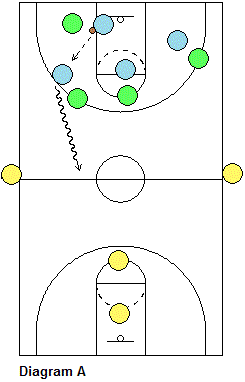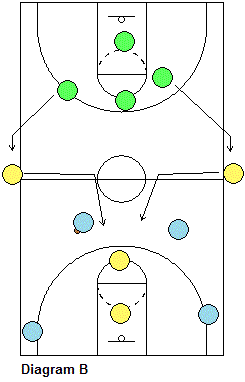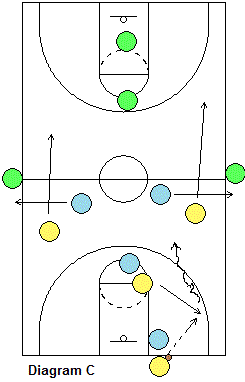Basketball Drill - 4-On-4-On-4 Full-Court Transition Drill
By Dr. James Gels, From the Coach’s Clipboard Basketball Playbook"Helping coaches coach better..."
This is a good full-court drill that emphasizes transition offense and transition defense as well as conditioning. Players and coaches like this drill and we run it nearly every practice. You need a minimum of twelve players, as we will have three 4-man teams. It helps if you have three sets of colored shirts.
See the diagrams below. Start with two 4-player teams on one end of the floor. The coach throws the ball against the backboard, and the team that gets the rebound makes the outlet pass and starts their fast break. The four players on defense (green team in diagram A) try to stop the offense in the backcourt, but as soon as the ball crosses half-court they are finished.
Two of those four will stay on the floor in the backcourt waiting for the next transition back up the floor (see diagram B). The other two exit to wait at sideline at half-court, one on each side of the floor.


Notice that the offense (diagram B, blue team) advances the ball up the court quickly, trying to score. Two defenders (yellow team, diagram B) will be waiting for them, and two additional (yellow) defenders will join in once the ball crosses the half-court line. Each of these defenders sprints out and touches the half-court circle, and then sprints in to help the other two defenders.
So the offense has a brief 4-on-2 advantage and tries to score before the other two defenders arrive. On the other hand, the two waiting defenders must learn how to stop the break. The top defender stops the ball and the bottom defender defends the paint to prevent inside passing and lay-ups.
If the blue team turns the ball over, or misses the shot, yellow rebounds and starts their fast break the opposite direction. Blue plays defense until the ball reaches half-court, and then the green team takes over, again with the two defenders on the side joining in after the ball crosses half-court.
See diagram C. If a team scores (blue), the defense (yellow) gets the ball out of the net and takes it out-of-bounds, running your press-breaker (a modified 4-man version), while the team that just scored immediately sets up your press defense and plays the press until the ball crosses half-court (where the next team picks them up). In this drill, backcourt pressing defenders should be tenacious and "stay in the press" as they don't have to worry about sprinting back on defense. If they steal the ball, they immediately attack to score, and if successful, re-set the press again.

Rotation:
Notice that two players come off the floor on the sideline as the ball crosses half-court, and two stay on the floor getting ready for the next transition up the floor. The next time, the two players that had previously gone to the sideline, now stay on the court and the other two go to the sideline at half-court.
Tips:
Try to divide the teams up equally with a post player, a point guard and wings on each team. Make sure that they are following your fast break rules. For example, when we have a 3-on-2 situation, we don't want the middle person penetrating below the free-throw line as this destroys spacing.
And when we have a 2-on-1 situation, we want the person with the ball to first think of attacking the hoop for a lay-up or foul, with the pass as the second option. We don't want to settle for an outside jump shot in this situation.
From a defensive standpoint, this is a great transition defense drill. The two back defenders should be stacked. The top defender stops the ball and the second defender closes-out on the first person to receive a pass, as the top defender then immediately sprints back as low as the lowest offensive player (see Transition Defense, 3-on-2 defense).
Each team keeps their own score. One-point for each basket, or if fouled. The first team to 7 wins, and the other eight players do push-ups or run. You can also add other scoring rules if you want - example, minus one point for a bad pass or turnover, or a missed box-out.